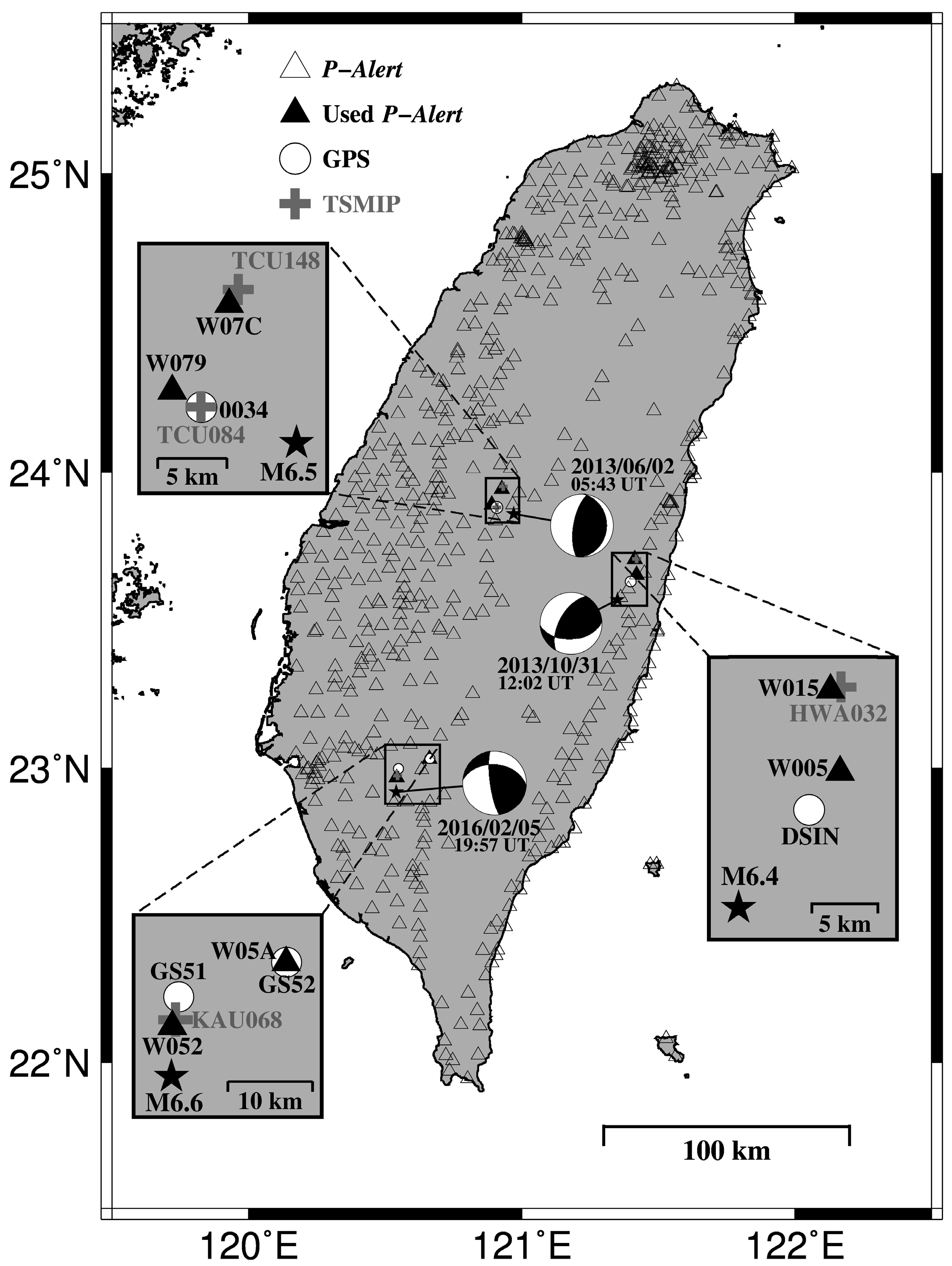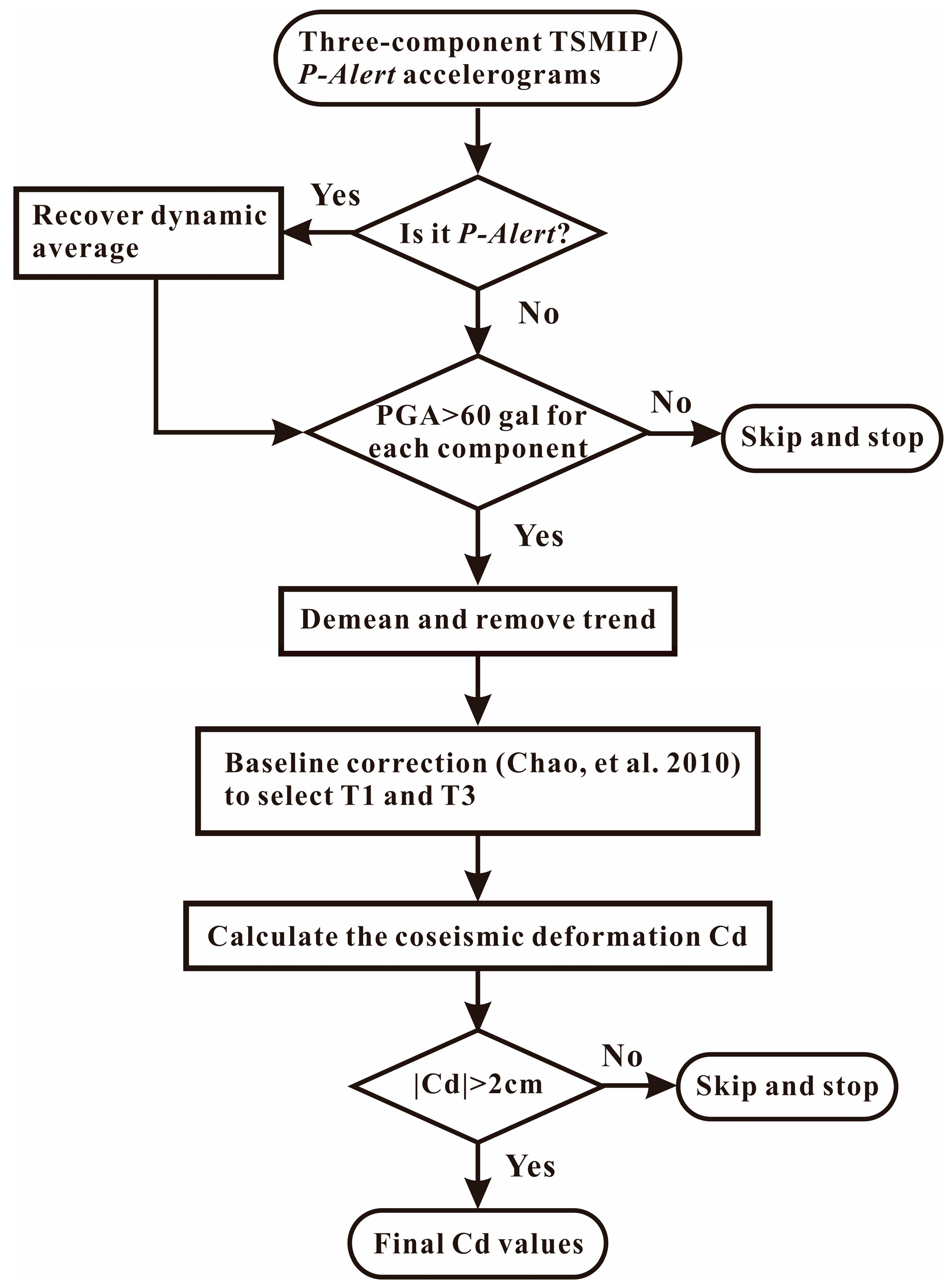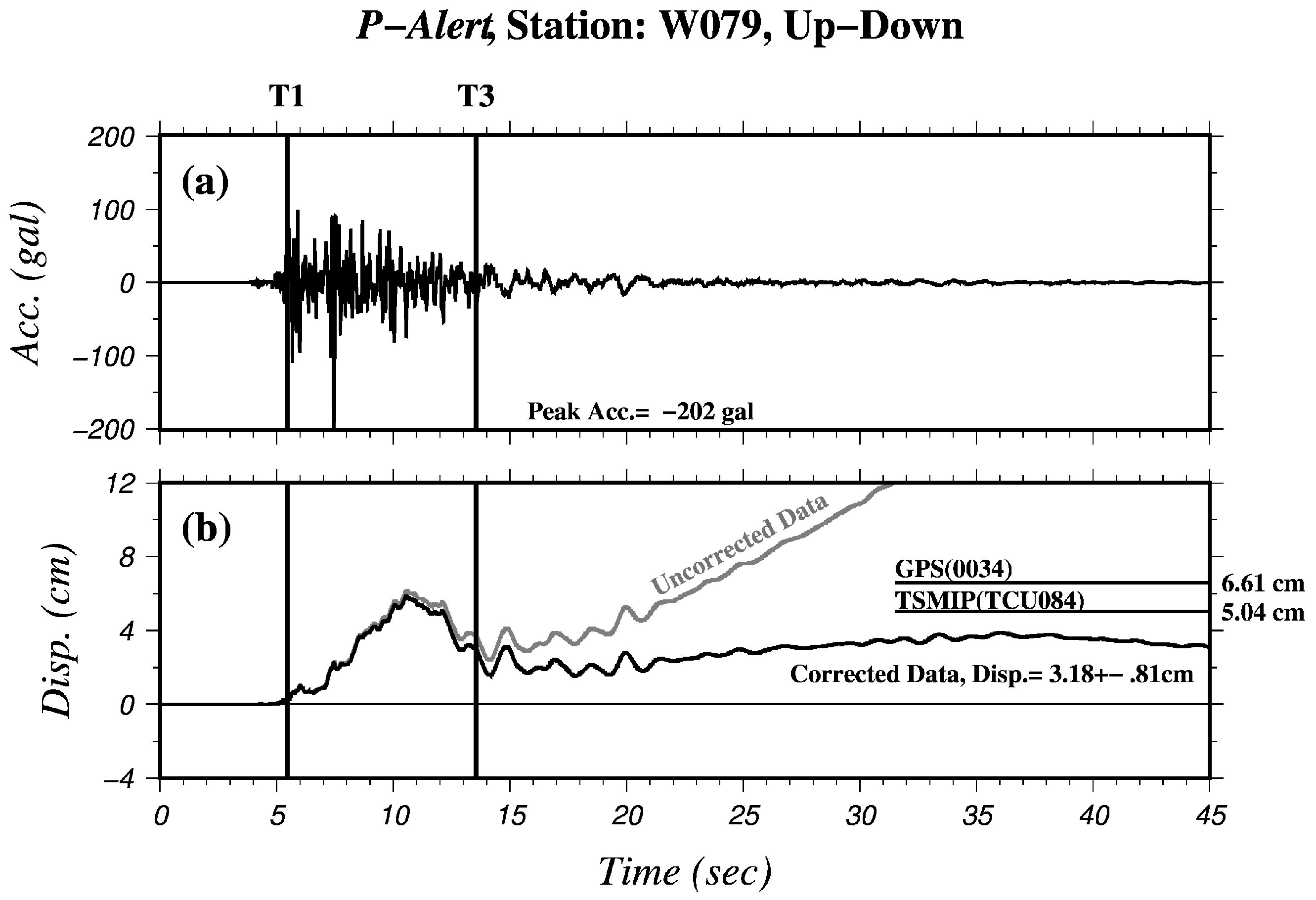How Well Can We Extract the Permanent Displacement from Low-Cost MEMS Accelerometers?
Abstract
:1. Introduction
2. Data and Method
3. Results
4. Discussion and Conclusions
Acknowledgments
Author Contributions
Conflicts of Interest
References
- Bogdanov, V.E.; Graizer, V.M. The determination of the residual displacement of the ground from the seismogram. Rep. Acad. Sci. USSR 1976, 229, 59–62. [Google Scholar]
- Iwan, W.D.; Moser, M.A.; Peng, C.Y. Some observations on strong-motion earthquake measurement using a digital acceleration. Bull. Seism. Soc. Am. 1985, 75, 1225–1246. [Google Scholar]
- Boore, D.M. Effect of baseline corrections on displacement and response spectra for several recordings of the 1999 Chi-Chi, Taiwan, earthquake. Bull. Seism. Soc. Am. 2001, 91, 1199–1211. [Google Scholar] [CrossRef]
- Wu, Y.M.; Chen, Y.G.; Shin, T.C.; Kuochen, H.; Hou, C.S.; Hu, J.C.; Chang, C.H.; Wu, C.F.; Teng, T.L. Coseismic vs. interseismic ground deformations, faults rupture inversion and segmentation revealed by 2003 Mw 6.8 Chengkung earthquake in eastern Taiwan. Geophys. Res. Lett. 2006, 33, L02312. [Google Scholar] [CrossRef]
- Wu, Y.M.; Wu, C. Approximate recovery of coseismic deformation from Taiwan strong-motion records. J. Seismol. 2007, 11, 159–170. [Google Scholar] [CrossRef]
- Chao, W.A.; Wu, Y.M.; Zhao, L. An automatic scheme for baseline correction of strong-motion records in coseismic deformation determination. J. Seismol. 2010, 14, 495–504. [Google Scholar] [CrossRef]
- Holland, A. Earthquake data recorded by the MEMS accelerometer: Field testing in Idaho. Seism. Res. Lett. 2003, 74, 20–26. [Google Scholar] [CrossRef]
- Wu, Y.M.; Chen, D.Y.; Lin, T.L.; Hsieh, C.Y.; Chin, T.L.; Chang, W.Y.; Li, W.S.; Ker, S.H. A high-density seismic network for earthquake early warning in Taiwan based on low cost sensors. Seism. Res. Lett. 2013, 84, 1048–1054. [Google Scholar] [CrossRef]
- Chen, D.Y.; Wu, Y.M.; Chin, T.L. Incorporating low-cost seismometers into the Central Weather Bureau seismic network for Earthquake Early Warning in Taiwan. Terr. Atmos. Ocean. Sci. 2015, 26, 503–513. [Google Scholar] [CrossRef]
- Wu, Y.M. Progress on development of an earthquake early warning system using low cost sensors. Pure Appl. Geophys. 2015, 172, 2343–2351. [Google Scholar] [CrossRef]
- Hsieh, C.Y.; Chao, W.A.; Wu, Y.M. An examination of the threshold-based earthquake early warning approach using a low cost seismic network. Seism. Res. Lett. 2015, 86, 1664–1667. [Google Scholar] [CrossRef]
- Hsieh, C.Y.; Wu, Y.M.; Chin, T.L.; Kuo, K.H.; Chen, D.Y.; Wang, K.S.; Chan, Y.T.; Chang, W.Y.; Li, W.S.; Ker, S.H. Low cost seismic network practical applications for producing quick shaking maps in Taiwan. Terr. Atmos. Ocean. Sci. 2014, 25, 617–624. [Google Scholar] [CrossRef]
- Wu, Y.M.; Liang, W.T.; Mittal, H.; Chao, W.A.; Lin, C.H.; Huang, B.S.; Lin, C.M. Performance of a low-cost earthquake early warning system (P-Alert) during the 2016 ML 6.4 Meinong (Taiwan) earthquake. Seism. Res. Lett. 2016, 87, 1050–1059. [Google Scholar] [CrossRef]
- Yin, R.C. An Experimental Study of the Low-Cost MEMS-Type Seismometer for Structural Health Monitoring. Master’s Thesis, National Taiwan University, Taipei, Taiwan, 2016. [Google Scholar]
- Yu, S.B.; Chen, H.Y.; Kuo, L.C. Velocity field of GPS stations in the Taiwan area. Tectonophysics 1997, 274, 41–59. [Google Scholar] [CrossRef]
- Chuang, R.Y.; Johnson, K.M.; Wu, Y.M.; Ching, K.E.; Kuo, L.C. A midcrustal ramp-fault structure beneath the Taiwan tectonic wedge illuminated by the 2013 Nantou earthquake series. Geophys. Res. Lett. 2013, 40, 5080–5084. [Google Scholar] [CrossRef]
- Chuang, R.Y.; Johnson, K.M.; Kuo, Y.T.; Wu, Y.M.; Chang, C.H.; Kuo, L.C. Active back thrust in the eastern Taiwan suture revealed by the 2013 Rueisuei earthquake: Evidence for a doubly vergent orogenic wedge? Geophys. Res. Lett. 2014, 41, 3464–3470. [Google Scholar] [CrossRef]
- Huang, M.H.; Tung, H.; Fielding, E.; Huang, H.H.; Liang, C.; Huang, C.; Hu, J.C. Multiple fault slip triggered above the 2016 Mw 6.4 MeiNong earthquake in Taiwan. Geophys. Res. Lett. 2016, 43, 7459–7467. [Google Scholar] [CrossRef]
- Wang, K.S.; Wu, Y.M.; Chao, W.A. Building effects on the P-Alert based real-time shacking map determination. 2017; in preparation. [Google Scholar]
- Graizer, V.M. Determination of the true displacement of the ground from strong-motion recordings. Izv. USSR Acad. Sci. Phys. Solid Earth 1979, 15, 875–885. [Google Scholar]
- Graizer, V.M. Tilts in strong ground motion. Bull. Seismol. Soc. Am. 2006, 96, 2090–2102. [Google Scholar] [CrossRef]
- Wessel, P.; Smith, W.H.F. New, improved version of Generic Mapping Tools released. EOS Trans. AGU 1998, 79, 579. [Google Scholar] [CrossRef]





| Station | U-D/N-S/E-W (cm) | SDV of U-D/N-S/E-W (cm) |
|---|---|---|
| W079(P-Alert) 2nd,2 TCU084(TSMIP) 0034(GPS) | +3.18/+2.34/−3.06 +5.04/+2.19/−2.34 +6.61/+3.12/−2.98 | 0.81/0.29/0.31 0.63/0.39/0.46 0.68/0.21/0.28 |
| W07C(P-Alert) 2nd,2 TCU148(TSMIP) | +2.71/+3.05/none +2.13/+3.37/none | 0.67/1.14/none 0.33/0.27/none |
| W005(P-Alert) 2nd,2 DSIN(GPS) | +6.18/−16.51/none +14.47/−3.75/none | 1.40/2.04/none 0.52/0.15/none |
| W015(P-Alert) 1st,1 HWA032(TSMIP) | +5.57/none/−3.02 +5.85/none/+2.08 | 0.56/none/0.60 0.56/none/0.38 |
| W05A(P-Alert) 1st,1 GS52(GPS) | −3.36/none/−4.98 −2.16/none/−3.26 | 0.43/none/0.59 0.29/none/0.36 |
| W052(P-Alert) 2nd,4 KAU068(TSMIP) GS51(GPS) | −2.34/none/−3.75 −2.81/none/−4.22 −2.93/none/−2.70 | 0.53/none/0.93 0.51/none/0.77 0.41/none/0.32 |
© 2017 by the authors. Licensee MDPI, Basel, Switzerland. This article is an open access article distributed under the terms and conditions of the Creative Commons Attribution (CC BY) license (http://creativecommons.org/licenses/by/4.0/).
Share and Cite
Jan, J.C.; Chao, W.-A.; Wu, Y.-M.; Chen, C.-C.; Lin, C.-H. How Well Can We Extract the Permanent Displacement from Low-Cost MEMS Accelerometers? Sensors 2017, 17, 2643. https://doi.org/10.3390/s17112643
Jan JC, Chao W-A, Wu Y-M, Chen C-C, Lin C-H. How Well Can We Extract the Permanent Displacement from Low-Cost MEMS Accelerometers? Sensors. 2017; 17(11):2643. https://doi.org/10.3390/s17112643
Chicago/Turabian StyleJan, Jyh Cherng, Wei-An Chao, Yih-Min Wu, Chien-Chih Chen, and Cheng-Horng Lin. 2017. "How Well Can We Extract the Permanent Displacement from Low-Cost MEMS Accelerometers?" Sensors 17, no. 11: 2643. https://doi.org/10.3390/s17112643






